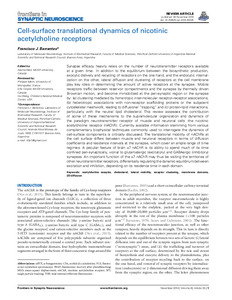Please use this identifier to cite or link to this item:
https://repositorio.uca.edu.ar/handle/123456789/8750| Título: | Cell-surface translational dynamics of nicotinic acetylcholine receptors | Autor: | Barrantes, Francisco José | Palabras clave: | MEDICINA; COLESTEROL; RECEPTORES; NEUROTRANSMISORES; MEMBRANAS CELULARES | Fecha de publicación: | 2014 | Editorial: | Frontiers | Cita: | Barrantes FJ (2014). Cell-surface translational dynamics of nicotinic acetyl-choline receptors. Front. Synaptic Neurosci. 6:25. doi:10.3389/fnsyn.2014.00025. Disponible en: https://repositorio.uca.edu.ar/handle/123456789/8750 | Resumen: | Abstract: Synapse efficacy heavily relies on the number of neurotransmitter receptors available at a given time. In addition to the equilibrium between the biosynthetic production, exocytic delivery and recycling of receptors on the one hand, and the endocytic internalization on the other, lateral diffusion and clustering of receptors at the cell membrane play key roles in determining the amount of active receptors at the synapse. Mobile receptors traffic between reservoir compartments and the synapse by thermally driven Brownian motion, and become immobilized at the peri-synaptic region or the synapse by: (a) clustering mediated by homotropic inter-molecular receptor-receptor associations; (b) heterotropic associations with non-receptor scaffolding proteins or the subjacent cytoskeletal meshwork, leading to diffusional "trapping," and (c) protein-lipid interactions, particularly with the neutral lipid cholesterol. This review assesses the contribution of some of these mechanisms to the supramolecular organization and dynamics of the paradigm neurotransmitter receptor of muscle and neuronal cells -the nicotinic acetylcholine receptor (nAChR). Currently available information stemming from various complementary biophysical techniques commonly used to interrogate the dynamics of cell-surface components is critically discussed. The translational mobility of nAChRs at the cell surface differs between muscle and neuronal receptors in terms of diffusion coefficients and residence intervals at the synapse, which cover an ample range of time regimes. A peculiar feature of brain α7 nAChR is its ability to spend much of its time confined peri-synaptically, vicinal to glutamatergic (excitatory) and GABAergic (inhibitory) synapses. An important function of the α7 nAChR may thus be visiting the territories of other neurotransmitter receptors, differentially regulating the dynamic equilibrium between excitation and inhibition, depending on its residence time in each domain. | URI: | https://repositorio.uca.edu.ar/handle/123456789/8750 | ISSN: | 1663-3563 (online) | Disciplina: | MEDICINA | DOI: | 10.3389/fnsyn.2014.00025 | Derechos: | Acceso abierto | Fuente: | Frontiers in Synaptic Neuroscience Vol. 6, N° 25, 2014 |
| Appears in Collections: | Artículos |
Files in This Item:
| File | Description | Size | Format | |
|---|---|---|---|---|
| cell-surface-translational dynamics.pdf | 3,27 MB | Adobe PDF |  View/Open |
Page view(s)
293
checked on Jan 16, 2026
Download(s)
192
checked on Jan 16, 2026
Google ScholarTM
Check
Altmetric
Altmetric
This item is licensed under a Creative Commons License

